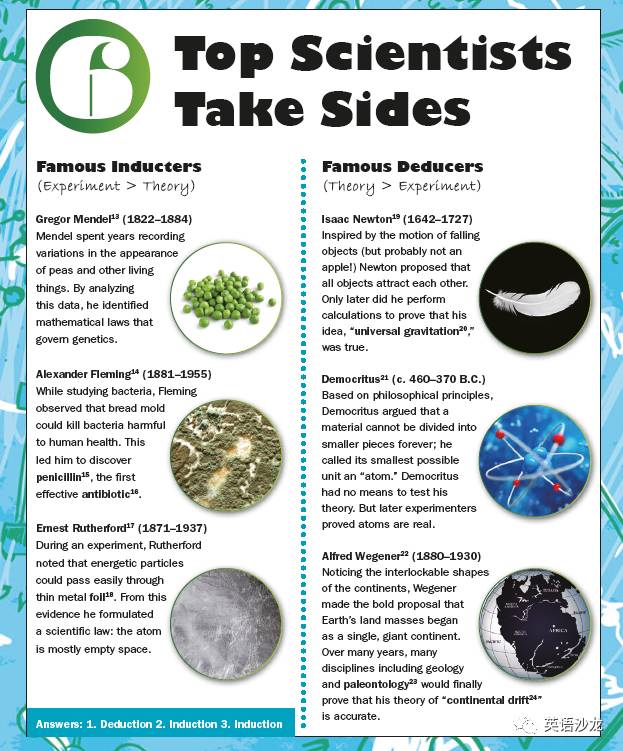探索科学奥秘有两种重要的方法,一种是像达尔文提出的归纳法;一个是爱因斯坦论述的演绎法。达尔文花了数年时间观察不同地区的动物外观和特性进行观察采集,最终提出了自然选择理论:物种可以根据环境而改变。阿尔伯特·爱因斯坦堪称是演绎推理之王,他总是提出一个大但的设想,然后通过大量的实验去证明,其中最著名的就是相对论中的质量与能量的相互转换(E = mc2)。无论是归纳法还是演绎法,只要你确立了正确的方向,两种方法可谓殊途同归。纵观历史,科学界的许多奥秘都是通过这两种方法得以解决。

There are at least two ways to approach a scientific mystery.
Induction (as described by Darwin), or deduction (as described by Einstein). Both methods can produce amazing results. But only when you know which “direction” to go.
The Steps Are the Same.
THEY INCLUDE:
Theory = An explanation of how things work
Experiment = A way to test what’s happening
Observation = Something you notice
Together, these are called the scientific method.*
*LONGER DEFINITIONS OF THE SCIENTIFIC METHOD MAY INCLUDE ADDITIONAL STEPS SUCH AS PREDICTION AND ANALYSIS.
Where to Begin?
Should you start from the “bottom” by collecting evidence and seeing where that leads you? That’s induction. Charles Darwin (1809–1882) championed this approach. He spent years observing the appearance and behavior of animals in different locales. From this, he formulated his theory of natural selection: that species can change because of their environment.
Or should you start from the “top” by formulating a theory and then seeing how it stands up in real life? That’s deduction. Albert Einstein (1879–1955) was king here. He began with bold ideas—for example, that mass and energy can convert into each other (e = mc2). These theories often took years to prove by experiment. A few of Einstein’s ideas are still being investigated.
Throughout history, science’s greatest mysteries have been solved using both methods (see 6 Top Scientists Take Sides).

So Which Way Is Best?
It depends on your point of view. Some researchers perform experiments and tests, and only later consider where their results may lead them. That’s induction. By comparison, deduction requires you to propose a theory that may or may not be supported by the evidence. You could say it’s more mysterious as well. For example, Einstein credited “intuition” for some of the questions that led to his great ideas.
Can You Use Both Methods?
Definitely. Many scientific discoveries result from a flexible attitude: beginning with a theory, for example, but changing it when experiments show something unexpected.
The best scientists are always ready to change approaches as the need arises.
Now It’s Your Turn.
Read the three mini-stories below. Then decide whether induction or deduction is being used to solve the problem. Notice that these stories aren’t all about science. That’s because we also use induction and deduction in our daily lives.(Answers below, right.)
1. For the science fair, Catherine proposes that red light will grow geraniums more effectively than green light. Her experiments later prove her theory is correct.
2. Cory uses a slow-motion camera to record gymnasts in action. Using this data, he devises a new method to dismount the balance beam.
3. To choose a band for the prom, Madison polls her classmates on their favorite music and recording artists.
Titan【希神】提坦;巨人
Induction 归纳法
Darwin 查尔斯·罗伯特·达尔文,英国生物学家,生物进化论的奠基人。
Deduction 演绎,推理
Einstein 阿尔伯特·爱因斯坦,犹太裔物理学家,现代物理学的开创者、奠基人,相对论——“质能关系”的创立者。他创立了代表现代科学的相对论,并在1921年获得诺贝尔物理学奖。
Gregor Mendel 格里哥·孟德尔,遗传学的奠基人,被誉为现代遗传学之父。
Alexander Fleming 亚历山大·弗莱明,英国细菌学家,生物化学家,微生物学家。弗莱明1923年发现溶菌酶,1928年首先发现了青霉素。
Ernest Rutherford 欧内斯特·卢瑟福,新西兰著名物理学家,被誉为原子核物理学之父。学术界公认他为继法拉第之后最伟大的实验物理学家,1908年获诺贝尔化学奖。
Isaac Newton艾萨克·牛顿爵士,英国皇家学会会长,英国著名的物理学家,百科全书式的“全才”,著有《自然哲学的数学原理》、《光学》。
universal gravitation 万有引力,万有引力定律是解释物体之间的相互作用的引力的定律。
Democritus 德谟克里特斯,古希腊哲学家,原子唯物论的创立者。
Alfred Wegener 阿尔弗雷德·魏格纳,德国地质学家、气象学家,提出大陆漂移学说,被称为“大陆漂移学说之父” 。
